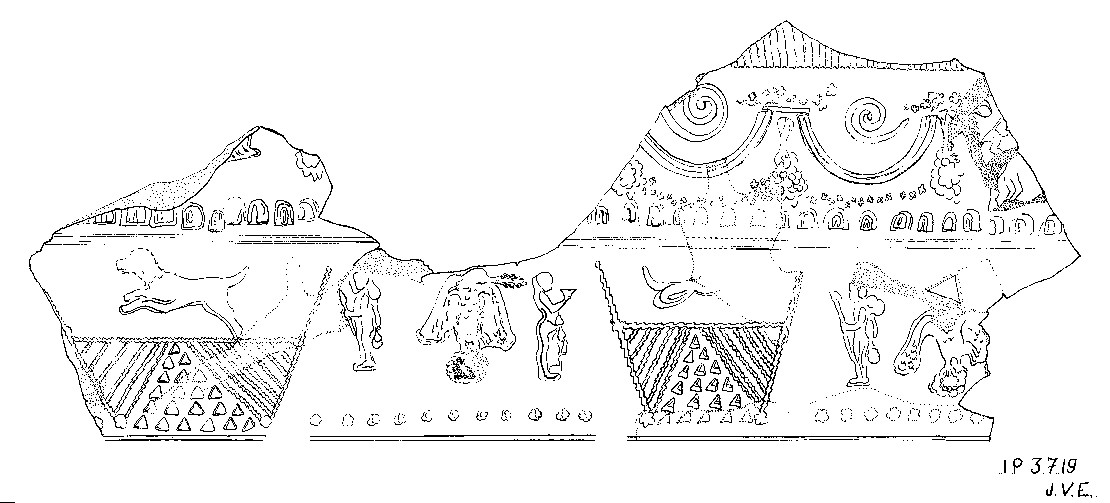
Regional Connections in a Panhellenic Setting: The Late Classical, Hellenistic, and Roman Pottery from Isthmia
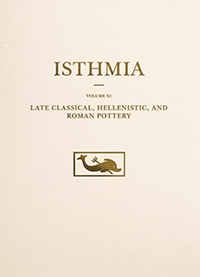 John W. Hayes and Kathleen Warner Slane’s new volume in the Isthmia series presents the Late Classical through Roman pottery uncovered between 1952 and 1989 by the University of Chicago excavations in and around the sanctuaries of Poseidon and Palaimon. Although much of the pottery is fragmentary, the authors demonstrate that the range of materials over this thousand-year period is typical of Corinthian sites, revealing just how closely the sanctuary was tied into the northeastern Peloponnese. At the same time, the distinctive assemblage of ritual vessels from the Palaimonion remains unique in this region. The finds thus provide critical information about the history of Poseidon’s Panhellenic sanctuary and the ritual activities that took place there. Slane recently took time to discuss this new Isthmia volume and how she came to be involved with the publication.
John W. Hayes and Kathleen Warner Slane’s new volume in the Isthmia series presents the Late Classical through Roman pottery uncovered between 1952 and 1989 by the University of Chicago excavations in and around the sanctuaries of Poseidon and Palaimon. Although much of the pottery is fragmentary, the authors demonstrate that the range of materials over this thousand-year period is typical of Corinthian sites, revealing just how closely the sanctuary was tied into the northeastern Peloponnese. At the same time, the distinctive assemblage of ritual vessels from the Palaimonion remains unique in this region. The finds thus provide critical information about the history of Poseidon’s Panhellenic sanctuary and the ritual activities that took place there. Slane recently took time to discuss this new Isthmia volume and how she came to be involved with the publication.
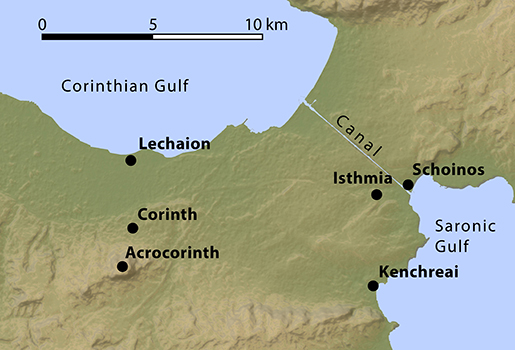
Map of the Corinthia, showing Isthmia in relation to Corinth and Acrocorinth (S. Rous; basemap J. Herbst)
Hayes’s experience with the Isthmia Excavations—like his involvement in many other excavations in Greece, Slane explains—began in the early 1960s when he was researching the dissertation that would become his authoritative Late Roman Pottery (1972). While Hayes was working at nearby Corinth, the Director of the Isthmia Excavations, Oscar Broneer, invited him to Isthmia to identify the Hellenistic and Roman pottery and to prepare a study of the Palaimonion pottery. Broneer’s successor, Elizabeth Gebhard, invited Hayes back to Isthmia in 1985 to work on the final publication of that material, which eventually came to include the Late Classical pottery as well. Hayes made many visits to Isthmia between 1985 and 2008 as work on the publication progressed. Slane’s initial contribution to the project occurred in 1989, when she was briefly consulted “on the thorny question of identifying the latest pottery,” she recalls, and she became involved again in more recent years when the catalogue had been completed and the manuscript needed further work that Hayes was no longer able to do. The most challenging task, she found, was “to fill in the regional comparanda that would substantiate the overall outline apparent in John’s manuscript and catalogue.” She reorganized the catalogue in an attempt to present larger groups of material and expanded some of the discussions, resulting in “what John outlined in the conclusion: an emphasis on the local and regional character of the pottery at Isthmia in all these periods.”
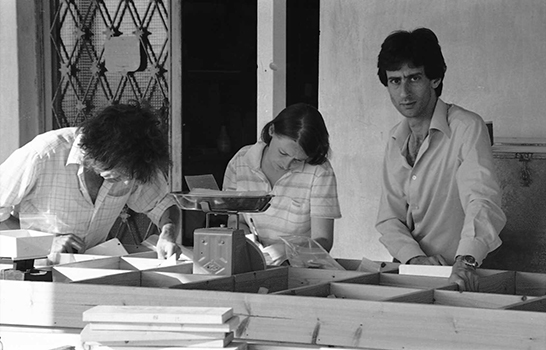
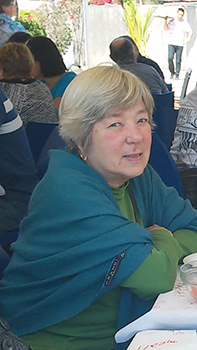
Left: John Hayes (at left) studies pottery at Isthmia with Catherine Morgan (center) and Karim Arafat (right) in 1989 (Isthmia Excavations).
Right: Kathleen Slane at Loutraki, near Isthmia, 2016.
When asked about the conception of Isthmia XI, especially the decisions made about what material to include, Slane explains that presenting the Late Classical and Hellenistic pottery (Chapter 2) and Roman pottery (Chapter 3) together made sense because, “compared to the massive amounts of sanctuary debris that were incorporated in building and rebuilding the Archaic and Classical sanctuaries of Poseidon, the amount of material from deposits of later date is small. There has been a great deal of deflation on the site, and the later deposits are found in pits or manholes in bedrock or where cellars and caves have been filled in.” Pottery from the Roman Sanctuary of Palaimon (Chapter 4) is more plentiful and well stratified, Slane notes, making it an interesting contrast to the Sanctuary of Poseidon. An appendix by Gebhard presents the phases and stratigraphy of the Palaimonion, while another appendix consists of Hayes’s observations on and reevaluations of the Palaimonion ritual lamps (already published by Broneer in Isthmia III), which he arrived at in the course of studying the ritual pottery Broneer had assigned to him. Two more appendixes on the stamped amphora handles and on the Slavic and Middle Byzantine pottery round out the volume. Slane identifies the amphora stamps as a topic particularly ripe for future reinvestigation, as they “need further explanation beyond what could be attempted in this volume.”
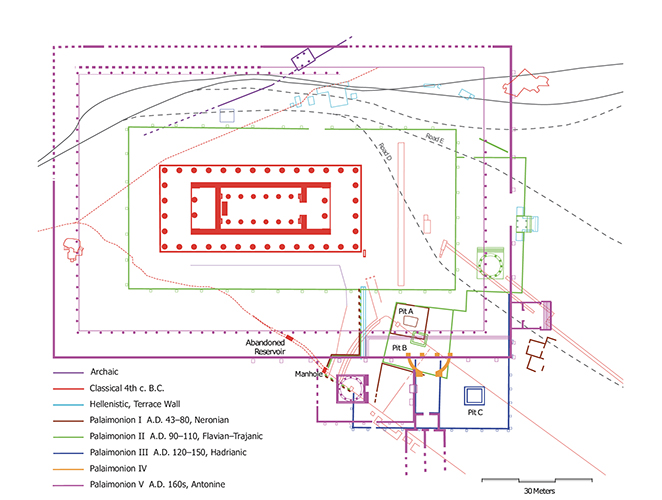
Phase plan of the temenos of Poseidon and of the Palaimonion (Isthmia Excavations, F. P. Hemans, 1996, modified by P. Sanders and J. Herbst, 2019)
The local and regional character of the Isthmian pottery from these periods is drawn out by comparison with material from the Sanctuary of Demeter and Kore on Acrocorinth in the volume’s concluding remarks, and Slane sees this volume as a complement to the Corinth XVIII publications of the Demeter sanctuary, including her own Corinth XVIII.2 on the Roman pottery and lamps. “The Hellenistic and Roman pottery from the Corinthia, not just the imported and local table wares but also the cooking pots, plain wares, and to a degree the amphoras,” Slane explains, “are the most fully published in Greece. I hope that its publication will encourage other sites to follow suit.” Comprehensive publication of such material from other sites and regions would allow scholars to pursue more nuanced questions. “In the future,” Slane suggests, “it will be of considerable interest to learn whether it is possible to discern variations in the assemblages from this and other sites that are not just chronological but in fact reflect variations in ritual practices or in food preparation or differences from domestic assemblages that we can’t quite see today.”

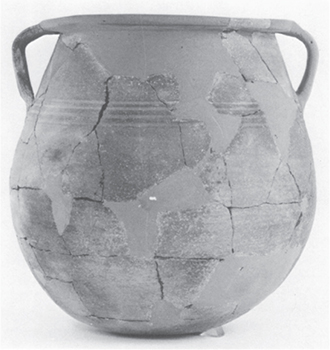
Cooking pot (P141) of the 3rd century A.D. from the Palaimonion at left and comparandum from the Sanctuary of Demeter and Kore on Acrocorinth (Corinth XVIII.2, no. 182) at right (Isthmia Excavations; Corinth Excavations)
The history of this publication project itself is an example of how new insights can arise as scholarly expectations change over time. When Broneer began excavating at Isthmia in the 1950s, Slane explains that as one of the four Panhellenic sanctuaries, “attention was on the international nature of the games, and one would have expected the pottery to differ greatly from that of a rural, peripheral sanctuary like the sanctuary on Acrocorinth. That is not the case. Our expectations have shifted in the past 70 years, and it is no longer so surprising, but still instructive, to see that both types of sanctuaries drew from the same range of materials.” Intriguingly, this regionalism evident in the Isthmian pottery is not seen in other categories of finds from Isthmia, such as metal objects. When asked what she finds most interesting among the Isthmian pottery, Slane identifies a class of imports that points to a revived interest in the Panhellenic sanctuary in the early Imperial period: “What really stood out to me was the presence and number of vessels of Late Italian and South Gaulish relief ware, almost all of which were found within the footprint of the Temple of Poseidon. They remind us of Nero’s performances at the games and also of his canal, although I think they may be a little later.”


Late Italian sigillata relief bowl (590) with figural and geometric decoration (P. Dellatollas)
As a seasoned expert in the Roman pottery of the Corinthia, Slane was well positioned to bring Hayes’s manuscript to publication. She describes her work on Isthmia XI as “a brief interruption in my long-term project of publishing the Roman pottery from east of the Theater at Corinth, which has now reached the stage of writing some of the catalogue.” Another of her ongoing projects is editing Elizabeth Lyding Will’s manuscript of stamped Roman amphoras found in the eastern Mediterranean. Slane’s commitment to helping publish manuscripts like Hayes’s and Will’s despite the challenges such projects involve is indicative of her overarching dedication to the thorough publication of archaeological material, founded on comprehensive research in excavation records. Projects like these and her 2017 volume on the material from Corinth’s northern cemetery excavated in the early 1960s (Corinth XXI) are sometimes described as the publication of “legacy data,” but Slane explains why she finds this term a misnomer:
I think it sets a very bad precedent to call material excavated in the pre-digital past “legacy data,” which is a term invented to explain why old excavation records are not being entered on a computer. It has nothing to do with the quality of the excavation or of the recording, saying only that it is different from the kind of field recording practiced today.
Slane gained valuable experience with Corinth’s recording systems during her dissertation work on the sigillata from the postwar excavations (after 1946), which led her “deep into the excavation records not only of the 1940s and 1950s but also of the 1930s.” She notes that publication has always been slower than excavation, and when she began working on the pottery from the Sanctuary of Demeter and Kore in 1979, “no one thought of materials from 1961–1973 as being particularly old, although it seemed much more so when Corinth XVIII.2 didn’t come out until 1990.” Her experience with that material was useful when she turned to the tombs of the northern cemetery in 1988, since the recording and storage methods used during their excavation in 1961 and 1962 were the same as those used in the Demeter sanctuary. The importance of such painstaking work with archival records, Slane emphasizes, is that “whenever it is possible to connect the inventoried and context pottery to stratigraphic descriptions of the excavation, fruitful work can be done—it’s a shame to ignore such material, and sometimes it’s easier to see the big picture than it is with the microrecording techniques used today.”
We commend both authors of Isthmia XI for their perseverance and dedication to bringing the Late Classical, Hellenistic, and Roman pottery from Isthmia to publication in this much-anticipated volume.
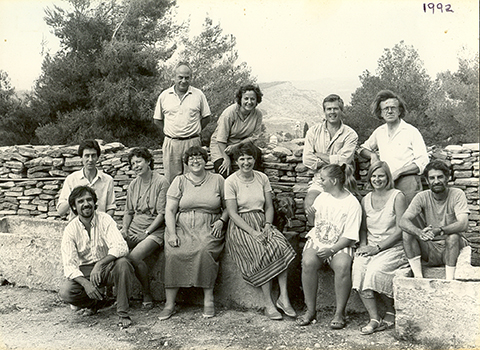
John Hayes with other scholars at Isthmia in 1992. Back row from left: Yannis Venetsanos, Stella Bouzaki, Eric Sorenson, John Hayes; front row from left: Michiel Bootsman (kneeling), Karim Arafat, Mary Sturgeon, Julie Bentz, Elizabeth Gebhard, Anna Stojanovic, Virginia Stojanovic, Frederick Hemans (Isthmia Excavations)
Late Classical, Hellenistic, and Roman Pottery (Isthmia XI) can be ordered from our distribution partners: Casemate Academic (in the United States) or Oxbow Books (outside of the United States).